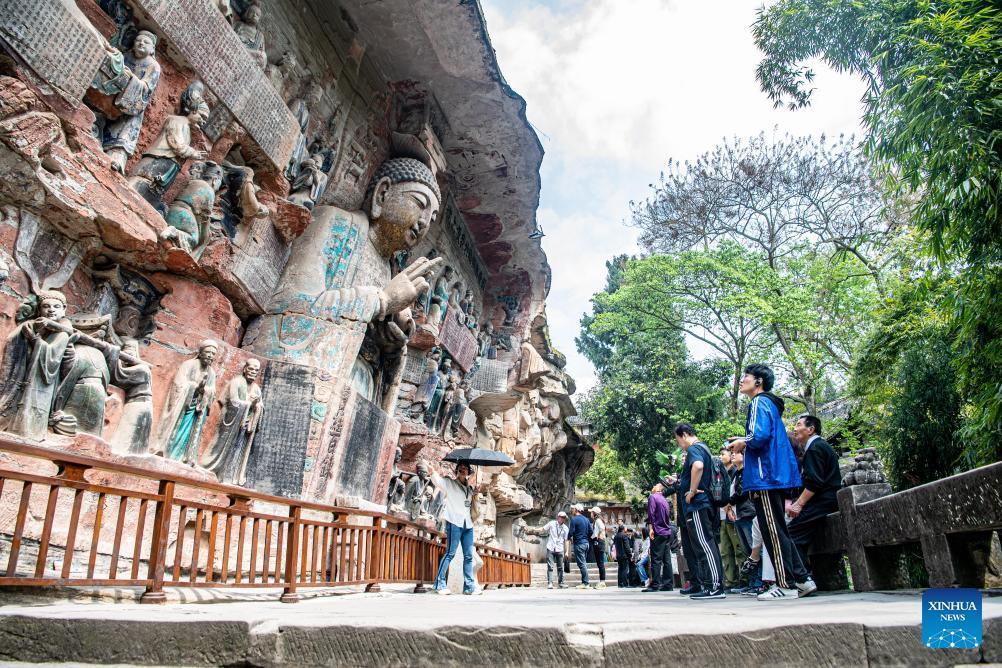
Tourists visit the scenic spot of Dazu Rock Carvings in southwest China's Chongqing, March 27, 2024. The Dazu Rock Carvings were placed on the World Heritage List by the United Nations Educational, Scientific and Cultural Organization (UNESCO) in 1999. (Xinhua/Tang Yi)
At key positions of the Dazu Rock Carvings, a UNESCO World Heritage Site in southwest China's Chongqing Municipality, hundreds of digital monitoring devices are placed to collect fundamental data such as meteorology, microenvironment and moisture content of the rock mass.
As a representative of Chinese grotto art, the Dazu Rock Carvings site is of profound historical significance, embodying the vigorous vitality of Chinese culture.
However, after years of erosion and weathering, the famous statue at this site, with a history dating back more than 1,000 years, began to show clear signs of damage.
Generations of conservation efforts have helped to slow the pace of damage, and guardians of the Dazu Rock Carvings have now also turned to the use of digital methods to fight against the destructive impact of time -- hoping to effectively restore and revive the rock carvings.
Yan Xuefeng, a 64-year-old restorer at the Academy of Dazu Rock Carvings, was standing in front of a stone Buddha statue at the Baoding Mountain scenic area of the Dazu Rock Carvings site. He was using precision technical equipment to check the development of rock cracks within the statue, a task which in the past had relied purely on human visual observation and experience.
In the early 1980s, the situation at the Dazu Rock Carvings was very different compared with today.
Back then, the venue was without management and this allowed weeds to flourish and dust to gather, while this mountainous region also faced serious challenges in terms of water, electricity and communication infrastructure at that time. In addition, access to the site was limited, with only narrow paths available to those wanting to reach it.
"As immovable cultural relics, the Dazu Rock Carvings have strong natural attributes, and cliff statues are sensitive to natural effects such as water seepage and weathering," Yan said, adding that water disasters not only destroy stone carvings and breed microorganisms, but are also significant in terms of the aggravation of weathering.
With the continuous improvement of internet technology and monitoring abilities and capacities, restorers can today carry out informatization construction to ensure both the security of cultural relics and good engineering quality.
In 2020, a monitoring and early warning system using technologies including Internet of Things, the internet and big data was put into use. The monitoring scope of this system covers 18 categories and more than 70 sub-items, such as stone carvings, the environment, human activities and protection management.
It realizes a complete digital chain of cultural heritage monitoring, including data collection, analysis, and docking, as well as monitoring and early warning, which strengthens the overall cultural heritage monitoring process. Thus, this system can provide a scientific decision-making basis for protection efforts at the Dazu Rock Carvings, and transform the protection strategy from passive protection to active protection, while also allowing an expansion from rescue protection to both rescue and preventive protection work.
At present, the rescue and protection project of Cave No. 176 to No. 180 of the cliff statue at Beishan Site of Dazu Rock Carvings, some of the caves with the most serious water damage, is progressing in an orderly manner and is expected to be completed in July this year.
"In the past it was a case-by-case approach, but now we are conducting comprehensive investigation and treatment," said Chen Huili, director of the protection engineering center of the Academy of Dazu Rock Carvings.
"We now have a comprehensive protection strategy including rock reinforcement, water seepage control, statue restoration, preventive protection, and monitoring and early warning system construction," Chen added.
According to Chen, a "hospital" for the Dazu Rock Carvings cultural relics can also provide standardized and scientific services from diagnosis to treatment for rock carving cultural relics, helping expand the lives of more damaged cultural relics.
In January 2024, a digital museum showcasing the Dazu Rock Carvings started trial operation, emerging as a new platform for display of the cultural heritage of the Dazu Rock Carvings, while also helping to advance preservation, research, and inheritance capabilities.
The platform revitalizes relics through digital technology and breathes new life into millennia-old rock carvings, spreading the charm of grotto art to a wider audience and helping to better meet the public's cultural demands. Enditem